
The northern bobwhite, also known as the Virginia quail or bobwhite quail, is a ground-dwelling bird native to Canada, the United States, Mexico, and Cuba, with introduced populations elsewhere in the Caribbean, Europe, and Asia. It is a member of the group of species known as New World quail (Odontophoridae). They were initially placed with the Old World quail in the pheasant family (Phasianidae), but are not particularly closely related. The name "bobwhite" is an onomatopoeic derivation from its characteristic whistling call. Despite its secretive nature, the northern bobwhite is one of the most familiar quails in eastern North America, because it is frequently the only quail in its range. Habitat degradation has contributed to the northern bobwhite population in eastern North America declining by roughly 85% from 1966 to 2014. This population decline is apparently range-wide and continuing.
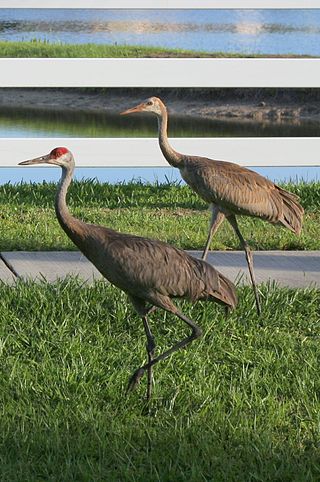
The sandhill crane is a species of large crane of North America and extreme northeastern Siberia. The common name of this bird refers to habitat like that at the Platte River, on the edge of Nebraska's Sandhills on the American Great Plains. Sandhill Cranes are known to hang out at the edges of bodies of water, especially in the Central Florida region. The central Platte River valley in Nebraska is the most important stopover area for the nominotypical subspecies, the lesser sandhill crane, with up to 450,000 of these birds migrating through annually.

The whooping crane is an endangered crane species, native to North America, named for its “whooping” calls. Along with the sandhill crane, it is one of only two crane species native to North America, and it is also the tallest North American bird species. The whooping crane's lifespan is estimated to be 22-24 years in the wild. After being pushed to the brink of extinction, due to unregulated hunting and loss of habitat, and just 21 wild cranes remaining by 1941, conservation efforts would lead to a partial recovery. The total number of cranes in the surviving migratory population, plus three reintroduced flocks and in-captivity, only slightly exceeds 800 birds as of 2020.

The El Segundo blue is an endangered species of butterfly. It is endemic to a small dune ecosystem in Southern California that used to be a community called Palisades del Rey, close to the Los Angeles International Airport (LAX).

The Palos Verdes blue is a small endangered butterfly native to the Palos Verdes Peninsula in southwest Los Angeles County, California, United States. As its distribution has been proven to be limited to one single site it has one of the best claims to being the world's rarest butterfly.

The Key deer is an endangered subspecies of the white-tailed deer that lives only in the Florida Keys. It is the smallest extant North American deer species.

The Karner blue is an endangered species of small blue butterfly found in some Great Lakes states, small areas of New Jersey, the Capital District region of New York, and southern New Hampshire in the United States. The butterfly, whose life cycle depends on the wild blue lupine flower, was classified as an endangered species in the United States in 1992.
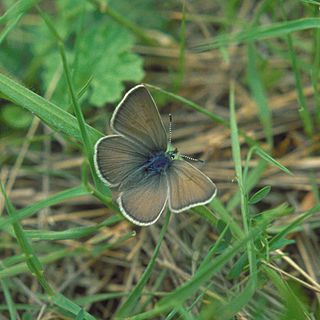
Fender's blue butterfly is an endangered subspecies of Boisduval's blue endemic to the Willamette Valley of northwestern Oregon, United States. The potential range of the butterfly extends from south and west of Portland, OR to south of Eugene, OR. The butterfly is host-specific on the Kincaid's lupine, which it relies on for reproduction and growth.
The Crocodile Lake National Wildlife Refuge is part of the United States National Wildlife Refuge System, located in north Key Largo, less than 40 miles (64 km) south of Miami off SR 905. The 6,686 acre (27.1 km2) refuge opened during the year of 1980, under the Land and Water Conservation Fund Act of 1965 and the Endangered Species Act of 1973. It was established in order to protect critical breeding and nesting habitat for the threatened American crocodile and other wildlife. This area also includes 650 acres (2.6 km2) of open water in and around the refuge. In addition to being one of only three breeding populations of the American crocodile, the refuge is home to tropical hardwood hammock, mangrove forest, and salt marsh. It is administered as part of the National Key Deer Refuge which is also located in the Florida Keys.
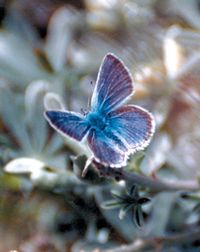
The Mission blue is a blue or lycaenid butterfly subspecies native to the San Francisco Bay Area of the United States. The butterfly has been declared as endangered by the US federal government. It is a subspecies of Boisduval's blue.

Cyclargus is a genus of butterflies in the family Lycaenidae. It was split off from the genus Hemiargus in 1948 by Vladimir Nabokov, although many lepidopterists have not accepted the new genus as valid. Nabokov designated C. ammon as the type species for the genus, and included C. dominica, C. thomasi, C. woodruffi and C. erembis. In 1992 K. Johnston and Matusik described C. sorpresus and C. kathleena, both from Hispaniola.

The wildlife of Cambodia is very diverse with at least 162 mammal species, 600 bird species, 176 reptile species, 900 freshwater fish species, 670 invertebrate species, and more than 3000 plant species. A single protected area, Keo Seima Wildlife Sanctuary, is known to support more than 950 total species, including 75 species that are listed as globally threatened on the IUCN Red List. An unknown amount of species remains to be described by science, especially the insect group of butterflies and moths, collectively known as lepidopterans.

Apodemia mormo langei, the Lange's metalmark butterfly, is an endangered North American butterfly. It is a subspecies of the Mormon metalmark and belongs to the family Riodinidae. The butterfly is endemic to California, where it is known from one strip of riverbank in the San Francisco Bay Area. A 2008 count estimated the total remaining population at 131 individuals. Since 2011, this number has dropped to about 25–30.

The Florida black bear is a subspecies of the American black bear that has historically ranged throughout most of Florida and the southern portions of Georgia, Alabama, and Mississippi. The large black-furred bears live mainly in forested areas and have seen recent habitat reduction throughout the state due to increased human development, as well as habitat modifications within bear habitat.
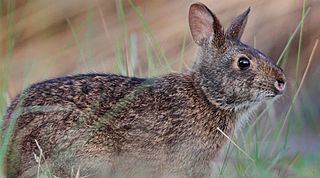
Sylvilagus palustris hefneri, also known commonly as the Lower Keys marsh rabbit, is an endangered subspecies of marsh rabbit in the family Leporidae. The subspecies is named after Playboy founder Hugh Hefner.

Papilio aristodemus, the Schaus' swallowtail or island swallowtail, is a species of American butterfly in the family Papilionidae. It is found in southern Florida in the United States and throughout the West Indies. It is named in honor of William Schaus.
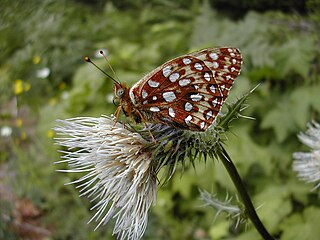
Speyeria zerene hippolyta, the Oregon silverspot, is a threatened butterfly that is found in the U.S. states of California and Oregon. It is a subspecies of Speyeria zerene.

The Florida grasshopper sparrow is an endangered subspecies of grasshopper sparrow native to the dry prairies of south-central Florida.

Forelius pruinosus, commonly known as the high noon ant, is a species of ant in the genus Forelius. Described by Roger in 1863, the species is endemic to North America and has been recently observed in Latin America.

Cyclargus thomasi, known generally as the Thomas's blue, Miami blue or Caribbean blue, is a species of butterfly in the family Lycaenidae. It is found in North America and the West Indies.





















